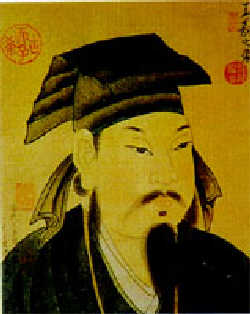| Created in China > Art Treasures > Chinese Calligraphy > Calligraphy Elites |
|
|
Wang Xizhi
Wang was born in a family of calligraphy, whose uncles and cousins were all famous calligraphers of their time. At the age of seven, Wang began a systematic study of calligraphy under a woman calligrapher - Wei Shuo. He kept copying the Wei-style calligraphy for five years and learned much from the work of previous calligraphers, including Zhong Yao's Kaishu, Zhang Zhi's Caoshu and that of Li Si and CaiYong. In order to practice calligraphy, wherever he went, he would try to find out the styles of previous dynasties and copy them, accumulating large amounts of calligraphic materials. There were writing brushes, ink sticks, papers and ink stones in his study, courtyard, gate way and even outside the toilet. Whenever he hit upon a good-
Some people have described his calligraphy as "the dragon jumping over the heavenly gate and the tiger lying in the watchtower of the phoenix." Wang's calligraphy has a quiet beauty. Compared with Zhong Yao's handwriting, Wang's calligraphy is less influenced by lishu. He wrote with more fluidity and grandeur. Though his style has survived to this day, original examples of Wang Xizhi's handwriting are rarely seen today. Most of the works we can see now are rubbed copies of his works by others. Wang Xizhi was good at many types of calligraphy but the xingshu-style Lan Ting Xu (Preface to the Literary Gathering at the Orchid Pavilion) is the most representative of his works. There is a story behind this work. In 353, Wang Xizhi invited 41 guests to join him at the Orchid Pavilion by a small, meandering stream for the purification rites of spring. Each guest was asked to compose a poem. The poems were collected, and Wang himself wrote the Preface to the Orchid Pavilion Collection in his trademark calligraphic style -- xingshu, a 324-character text in 28 lines, recording the happy gathering of intellectuals. Wang's calligraphy ability was brought into full play during the gathering. The Song Dynasty scholar Mi Fu called the Preface to the Orchid Pavilion Collection the world's best work in xingshu style. It is said that Emperor Taizong of the Tang Dynasty (618-907) treasured the work and had it buried in his tomb. Therefore, what we see now are only copies by others of this magnificent work. Author£»Jessie |
||||
 |

